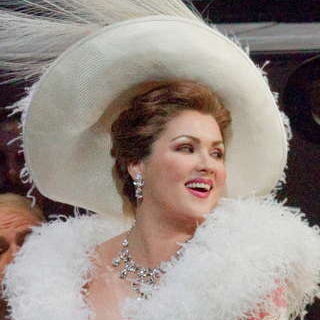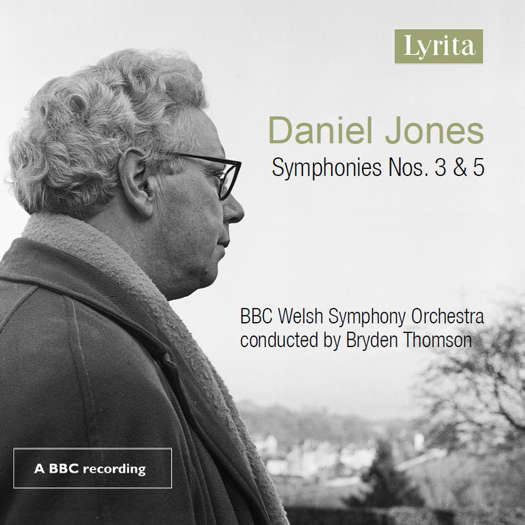 SPONSORED: Vocal Glory - Massenet's Manon in HD from New York Metropolitan Opera, enjoyed by Maria Nockin.
SPONSORED: Vocal Glory - Massenet's Manon in HD from New York Metropolitan Opera, enjoyed by Maria Nockin.
All sponsored features >>
 VIDEO PODCAST: John Dante Prevedini leads a discussion about The Creative Spark, including contributions from Ryan Ash, Sean Neukom, Adrian Rumson, Stephen Francis Vasta, David Arditti, Halida Dinova and Andrew Arceci.
VIDEO PODCAST: John Dante Prevedini leads a discussion about The Creative Spark, including contributions from Ryan Ash, Sean Neukom, Adrian Rumson, Stephen Francis Vasta, David Arditti, Halida Dinova and Andrew Arceci.
 SPONSORED: Think of Something Beautiful - Malcolm Miller pays tribute to contralto Sybil Michelow (1925-2013).
SPONSORED: Think of Something Beautiful - Malcolm Miller pays tribute to contralto Sybil Michelow (1925-2013).
All sponsored features >>

A Strange Beauty
Symphonies by Daniel Jones, heard by GEOFF PEARCE
'The BBC Welsh Symphony Orchestra delivers fine performances, as does the direction of its conductor, Bryden Thomson.'
I had never heard of Daniel Jones (1912-1993) or his works before, so was keen to listen to this composer of thirteen symphonies, two operas and many other works. The programme notes are excellent and give a sound breakdown into the workings of both symphonies on this CD.
The Third Symphony was written in 1951 and was premiered the following year by the BBC Welsh Symphony Orchestra - the orchestra on this recording - with the composer conducting in a studio broadcast recording. The opening movement begins quietly and slowly before the tempo speeds up and the music becomes more rhythmic and resolute. Jones is a competent orchestrator, and the music shows both melodic and rhythmic interest and variety. In the middle there is a fugal section that is disquietingly restless in nature. Whilst the character of the work is rather forceful in nature, there are also quieter and more reflective passages which stop one feeling overwhelmed.
Listen — Daniel Jones: Allegro moderato (Symphony No 3)
(track 1, 6:04-6:42) ℗ 2021 BBC under licence to Lyrita Recorded Edition :
The second movement is marked Lento and is the dramatic core of the symphony. It starts with unison strings. It is stark and remote, and then there is an eerie brass chord and melodies on oboe and cor anglais before other wind is added. The music meanders slowly at times, building in power before subsiding, and there is some very effective writing here. There's also a kind of remoteness or a feeling of open space, before the music becomes more agitated and then the opening calmness and remoteness returns. This music has a strange beauty.
Listen — Daniel Jones: Lento (Symphony No 3)
(track 2, 4:30-5:15) ℗ 2021 BBC under licence to Lyrita Recorded Edition :
The Third movement is an Allegro that serves both as a scherzo and as a finale. It is rhythmically charged and is constantly changing in character, but there is a cohesiveness and sense to the whole work that one never gets lost in what is happening. There is always plenty of interest and the composer is a master of form but is also economical and one is never bored by endless repetition. The composer states his material clearly without unnecessary fuss.
Listen — Daniel Jones: Allegro (Symphony No 3)
(track 3, 5:13-6:02) ℗ 2021 BBC under licence to Lyrita Recorded Edition :
The Fifth Symphony is a four movement work, written in the latter half of 1958 and performed early the following year, this time in the Royal Festival Hall, with the BBC Symphony Orchestra conducted by the composer. It is scored for a medium sized orchestra.
The first movement starts without any introduction and immediately I felt it was a warmer and more approachable and expansive work when compared with the Third Symphony. Again the composer shows he is a master of form, and he often employs complex metres - a 'complex metre' being an irregular time pattern (e.g. 5/4 – 3/2) regularly maintained throughout a movement or long section. This does not detract at all from the overall listenability of the work.
Listen — Daniel Jones: Allegro moderato (Symphony No 5)
(track 4, 6:12-6:55) ℗ 2021 BBC under licence to Lyrita Recorded Edition :
The second movement is another fast one. It does not really have the characteristics of a scherzo, although there is a trio section which is slower, more brooding and which also shows some deliciously tender moments. A three-note glockenspiel figure signals the commencement of each section and, like all the other movements, the 'complex metres' device is used constantly. There is a lightness to the work that belies the movement's seriousness.
Listen — Daniel Jones: Allegro assai (Trio) (Symphony No 5)
(track 5, 3:05-3:46) ℗ 2021 BBC under licence to Lyrita Recorded Edition :
The next movement, marked Lento, starts with a rhythmic timpani figure which again not only forms part of the melodic structure but also serves to mark the sections. The rhythmic figure is also shared by some of the other sections of the orchestra and helps serve as a unifying device. The character is very much like a funeral march in effect, and to me, this is the symphony's most touching movement. It has a powerful dramatic and emotional intensity to it.
Listen — Daniel Jones: Lento (Symphony No 5)
(track 6, 1:58-2:44) ℗ 2021 BBC under licence to Lyrita Recorded Edition :
The final movement, Allegro Moderato, is music with a number of changes in mood and a complicated contrapuntal section. I found this perhaps the most sombre of all the movements, at times reminiscent of the more austere Third Symphony, but at the same time, not out of character with the rest of the work, and providing a fitting finale.
Listen — Daniel Jones: Allegro moderato (Symphony No 5)
(track 7, 5:03-5:49) ℗ 2021 BBC under licence to Lyrita Recorded Edition :
I hope that there is wider interest in this fascinating and skilled Welsh composer. There are so many fine composers, especially from the mid twentieth century, who fall outside the ultra-modern or the ones who have their feet stuck in an earlier century, and who enjoyed a brief flurry of fame, but are now largely forgotten. The BBC Welsh Symphony Orchestra delivers fine performances, as does the direction of its conductor, Bryden Thomson. I felt the sound of the recording was a little on the dry side, at least on my equipment.
Copyright © 6 April 2021
Geoff Pearce,
Sydney, Australia

CD INFORMATION - DANIEL JONES: SYMPHONIES NOS 3 AND 5


